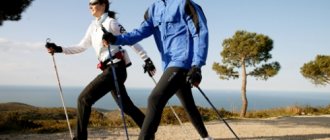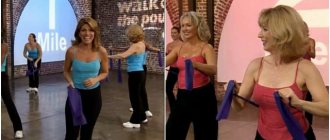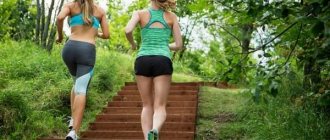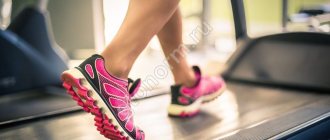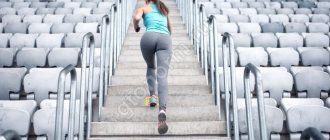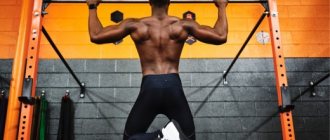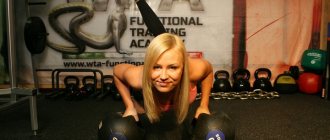Many articles have been written about the benefits of walking. It is usually talked about as a means to improve health and lose weight. Today we’ll try to figure out if all this is true. But let's say it right away. The article is for informational purposes and talks about general provisions. It is better to choose a method for losing weight with a specialist, because each patient’s case is unique. The Doctor Bormental clinic uses its own patented method of losing weight and maintaining results, with the help of which more than half a million people have already lost weight. Read more about her here -.
Benefits and Benefits of Walking for Weight Loss
Walking is a simple form of physical activity that is accessible to everyone. It is classified as low-intensity aerobic exercise. While walking, your heart rate increases only slightly or does not go beyond normal limits at all. This type of exercise is useful not only for weight loss, but for improving the health of the body.
Relatively recently, two young specialists from an English university conducted a meta-analysis. In their work, they compiled and analyzed a wealth of scientific data related to walking from 1970 to 2007. In total, about 4,300 research papers passed through them. 18 of them were particularly large and were based on studies of almost half a million patients. Based on the results of data analysis, they established two key patterns:
- regular leisurely walks, at least half an hour daily, reduce the risk of cardiovascular diseases to;
- The risk of mortality from cardiovascular diseases in people who regularly walk is reduced by 32%.
The data obtained became a real discovery in the world of evidence-based medicine. But that is not all. Other positive effects on the body have been identified and proven:
- Strengthening the respiratory system.
- Increased endurance.
- Strengthening the body's defense reactions. It is better resistant to pathogenic bacteria and viruses.
- Strengthening muscles. The back, buttocks, and thighs are especially strongly involved.
- Stabilization of the psycho-emotional state.
- Reducing anxiety, insomnia.
- Normalization of blood pressure.
It is not necessary to walk for many hours. How long should the walk last? How to prepare for it? What uniform should I wear? Let's talk in more detail in other sections of the article.
Nordic walking: how it is useful and to whom it is indicated.
Nordic walking: how it is useful and to whom it is indicated.
Today, a type of physical activity such as Scandinavian (or Nordic) walking, which is based on a certain movement technique using poles reminiscent of ski poles, is gaining increasing popularity.
How is such walking useful? Who is it shown to?
Let's learn a little about Nordic walking: According to one version, this type of physical activity was first described by a native of Finland, Marco Kantaneva. Walking and running with poles were used by skiers as training exercises outside the winter season. In addition to helping athletes prepare for competition, Nordic walking has been proven to have health benefits for people of all fitness levels. Walking with Nordic poles is a great way to strengthen your cardiovascular system, tone your muscles, and get a boost of vigor and energy.
Let's look at some of the features of this activity: You move with additional weight. The poles weigh little, but after 30–60 minutes even this small weight will seem much heavier than at the beginning of the walk. This means that the load on the muscles is greater than during normal walking. Every step you take, you swing your arm. This means that, in addition to the legs, the shoulder girdle will work. For people with osteochondrosis and simply a sedentary lifestyle, this is a big plus: blood circulation throughout the body improves, muscles not involved in normal life are trained. For breathing, raising your arms at each step will be very useful - the chest expands, and as you lower your arms, it narrows. Thanks to this, the lungs are better ventilated. A plus to this will be an increase in lung volume due to increased load. As a result, increased endurance and better saturation of tissues with oxygen. Don't be alarmed by the word "Increased load" in the previous paragraph. You can calmly control the speed and activity of movements. Relying on poles significantly increases your stability on the road. Uphill climbs are easier. For people who have begun to develop diseases of the musculoskeletal system, Nordic walking (it is also called that) will be much easier than usual. This is due to the fact that the body weight is redistributed due to support on sticks. And one more advantage associated with poles - when you get up to rest, you can lean on the poles and throw a significant part of your weight onto them. This significantly reduces the load on your back, which you will immediately feel. There are no contraindications for Nordic walking.
Nordic walking is considered one of the safest sports. The Nordic walking technique is simple and does not require any special skills or abilities. This type of activity is very effective in terms of weight loss. People who are losing weight are often advised to run. But active running can be hampered by excess weight, unpreparedness of the cardiovascular system, and problems with the joints and spine. But everyone can walk. Here Scandinavian or Swedish walking with poles helps a lot. In terms of calorie consumption, this activity will be almost equivalent to jogging. In addition, you can walk many times longer than you can run. Answering the question of what Nordic walking is, it is worth saying that it is not some special Nordic, Swedish or Finnish walking. All people move the same way - on two legs. It's just that here you use the support of the stick with every step. In our country, walking with ski poles is more common, because people do not always have the opportunity to purchase special equipment for this purpose. And our winter is long, there is a lot of snow - ski poles are quite suitable for such conditions. True, if you knock them on the asphalt, it will be uncomfortable. There is a lot of talk today about the benefits of Nordic walking. Some go with ski poles, some take 2 canes, and some buy exclusively expensive equipment from leading brands.
So, what are the benefits of Nordic walking: Improved blood circulation. Shoulder girdle training Prevention of osteochondrosis: strengthening muscles, reducing the load on the spine. The possibility of long walking increases all its beneficial properties many times over, compared to running. But on the contrary, there are fewer negative factors.
Nordic walking for pensioners is one of the few sports that they can safely practice without risk to health. Doing Nordic walking is good for the respiratory system - it has been proven that the lungs are trained and ventilated. And this ensures the prevention of respiratory infections. A corollary from the previous point is blood oxygen saturation. O2 molecules will be delivered to every cell of the body. A 40-60 minute walk at an average pace is enough. The rehabilitation benefits have been proven (and this is fully applied today). Nordic walking is used as rehabilitation after fractures of the hip, knees, and lower legs. People walk with poles as additional support - which provides better stability and reduces the load on the healing bones.
And remember that your task is to regularly and happily take walks with poles at distances that are comfortable for you, and not to set world records, bringing your body to exhaustion!
Take care of yourself! Be healthy and always remember: movement is life!
How to prepare for a walk?
How to practice walking to get maximum benefits? The first thing is to prepare properly. Preparation consists of several main points.
- Clothes should be comfortable, pleasant to the body, convenient, and not restrict movement. It is important to choose clothes according to the weather. In summer - a light cotton set. In winter - thermal underwear, boots, jacket, hat, scarf, gloves.
- The shoes chosen are comfortable, reliable, convenient, warm, if we are talking about a winter walk, with reliable protection from moisture. Experts recommend walking in orthopedic boots or purchasing special insoles that reduce the load on the joints and spine.
- You need to prepare auxiliary equipment depending on the situation - a belt bag for house and phone keys, a backpack, sunglasses, a hat, an umbrella, a raincoat, water. In general, something that will make the walk comfortable and enjoyable.
Also, don't forget about the skin. In summer it is better to apply sunscreen, and in winter - a nourishing, oily one to protect your face and hands from the negative effects of frost, precipitation, and wind.
How and how long should you walk?
In order for the body to begin burning fat when walking, it is worth remembering a few simple rules:
- You need to walk continuously throughout the lesson.
- The distance should be from 5 to 7 kilometers, or at least 60 minutes in time.
- Do not forget about the pulse readings, which should range from 114 to 133 beats in 60 seconds.
- You need to do walking every day.
These principles must be followed in order for long walking to be effective.
Important: this method of weight loss does not give an immediate effect. Therefore, you should not quit classes after a month or two. Only regular and constant exercise will give effect and allow the body to always be in good shape.
In addition to following the basic principles, you need to think through the entire lesson plan. It could be as follows:
- conduct classes in the morning, after having a light breakfast;
- think over a route plan, without pauses or delays in movement;
- choose shoes and clothes that do not restrict movement;
- warm up before walking;
- monitor the work of your arms and legs when moving, breathe correctly;
- Drink water at any stage of training.
Morning exercises are most effective in terms of burning fat; it is at this time of day that the metabolism accelerates, which will remain so throughout the day.
Do not forget that the process when your body begins to use fat deposits develops after the 45th minute of intense exercise. Before this, glucose and glycogen stored in the human body are used.
Uncomfortable shoes and clothes will make walking a chore. It should be free, not restrict movement, and at the same time allow the body to breathe.
It is advisable to walk on dirt paths, away from moving traffic.
Before walking, you need to stretch and warm up your muscles, increase their elasticity, so that when moving over rough terrain, when going up and down, you can avoid injuries.
Stress on the body causes sweating, and as a result, dehydration. This should be avoided in every possible way, so you can drink water before walking, after, and also take a container with you with a small supply.
Walking for weight loss. The right approach
A leisurely walk will be beneficial for the whole body if it brings pleasure. Simply clocking up kilometers will not improve your psycho-emotional state in any way. On the contrary, such a test will forever discourage the desire to walk. Therefore, even in this simple version of physical activity, it is recommended to adhere to certain rules and principles. Let's look at the most important of them.
Count calories
The main principle of weight loss is creating a calorie deficit. Walking will not help you lose weight if your daily intake is many times higher than normal. To burn the calories received from food, you will have to walk many kilometers:
- hamburger - at least 4 kilometers;
- a small can of cola (330 ml) - almost 2 km;
- French fries - 6 km;
- Snickers - 3 km;
- pizza - 5 km;
- cake - 7 km.
But this is only a small part of the food that you can eat in a day. To really lose weight from walking with the same diet, you will have to walk about 20-25 km daily. And this is a 4-5 hour walk. Not everyone can withstand that much.
Increase your speed gradually
One of the questions that worries people is what is more effective: running or walking for losing weight? Each method has certain advantages and disadvantages. While leisurely walking is recommended for almost everyone, running has a fairly wide list of contraindications. For example, overweight people are not recommended to run. This can lead to injuries to the joints, spine, and problems with the cardiovascular, respiratory, and support systems.
A brisk walk is another matter. The main thing is to increase the speed gradually, as you get used to it. For the first few weeks, walk at your usual rhythm, and then move on to Nordic or interval walking.
Recommended Products
To lose weight while staying healthy, you need to maintain a calorie deficit. But this does not mean that you will have to starve yourself by following radical diets. Every day the body needs nutrients, proteins, fats, carbohydrates, vitamins, minerals. They get them from food. Therefore, it is recommended to include the following products in your diet:
- vegetables;
- fruits;
- lean meats;
- fish;
- fermented milk products;
- low fat curd cheese;
- wholemeal bread;
- cereals, cereals;
- mushrooms.
It is recommended to make the menu for every day varied, tasty, and nutritious. The main thing is to maintain the calorie norm, and do not forget about the ratio of proteins, fats, and carbohydrates.
Tone your body
When walking, it is recommended to monitor your body position. It should be in good shape, a little tense. Then you will be able to use the maximum number of muscles, turning an ordinary leisurely walk into an intense workout:
- Bend your elbows and move them actively to the rhythm of walking. That is why it is recommended to put personal belongings in a belt bag or backpack so that nothing interferes with movement.
- Keep your back straight, don't slouch your shoulders.
- Try to pull in your stomach a little, tighten your abdominal muscles.
- Watch your breathing. It should be calm, measured, without shortness of breath.
Such simple tips will help you use your muscles as much as possible and get the benefits of walking.
How much water to drink
Drink water in small sips as needed. Drinks should not contain sugar, caffeine, dyes, or preservatives.
Throughout the day, it is necessary to monitor the amount of drinking water consumed and adhere to the norm. Doctors recommend determining your individual daily water intake at the rate of 30 ml per kilogram of weight.
It is recommended to eliminate or minimize alcohol consumption. It has quite a lot of calories. It is better to direct them to healthy, nutritious, vitamin-rich foods.
Who can benefit from walking?
The answer is everyone. Starting from small children to old people. This method of burning fat is the most universal. It's no secret that people of all ages who are overweight often have contraindications for physical activity.
Diseases of the heart, blood vessels, and joints do not allow doing anything else. And excess weight only contributes to the exacerbation of such diseases. Walking in this case is a panacea.
But for developed and strong people, you shouldn’t limit yourself to fitness with a trainer in the gym. Firstly, such exercises do not take place every day, and secondly, walking is the most universal means for burning fat.
By devoting an hour of your life to walking, you thereby extend it by years and decades. Regular exercise makes a person healthier, more active and more cheerful.
How many calories can you burn if you walk?
The number of calories burned depends on body weight, duration of the walk, and step speed. On average, in 30 minutes you can walk 2-3 km and burn 100-150 kcal. Much depends on physical fitness and age. For example, a woman or man under the age of 40, when metabolic processes are not yet slowed down, will be able to lose weight faster than representatives of the older generation. Below is a table showing approximate values.
| Speed, km/h | Number of calories burned per hour depending on body weight in kg | |||||
| Up to 55 | Up to 65 | Up to 75 | Up to 85 | Up to 95 | Up to 100 | |
| 2 | 78 | 132 | 156 | 168 | 180 | 240 |
| 3 | 120 | 162 | 192 | 210 | 228 | 270 |
| 4 | 180 | 198 | 228 | 252 | 270 | 300 |
| 5 | 240 | 282 | 288 | 318 | 342 | 402 |
| 6 | 270 | 312 | 336 | 384 | 420 | 420 |
These figures are approximate and may vary depending on age, percentage of body fat and muscle. A fitness bracelet will be a useful gadget for hiking. It automatically calculates the number of steps, mileage, and calories burned.
How much and how to walk?
Walking has a positive effect on the entire body. And it doesn’t matter when to go for a walk.
- Morning walking energizes you for the whole day, helps you cheer up and wake up. You can walk to work or school, for example.
- Daytime helps get rid of unnecessary thoughts, tidy up the mind, and increase concentration.
- Evening relieves stress, tension, and fights insomnia.
But experts do not recommend walking in hot or extreme cold. You should refrain from walking during periods of illness.
To generally strengthen the body, it is enough to walk 20-30 minutes daily. Gradually increase the duration to 40-60 minutes. Ideally, take walks daily or 4-5 times weekly.
Warm-up
It’s right to start your walk by warming up your joints. It will reduce the risk of joint and spine injuries and make walking pleasant and comfortable.
Warm-up should take about 3-5 minutes. Do the following exercises:
- Head tilts. Forward, backward, left, right.
- Rotations in the shoulder and elbow joints.
- Bend the torso forward.
- Knee rotations.
- Jumping in place (10-15 times).
- Lunges forward.
These exercises are quite enough to warm up and prepare the body for a walk.
Walking technique
The walking technique is quite simple and understandable to many. It does not have any special nuances or features. But there are a few rules to remember. They will help avoid injuries and various health problems:
- Do not walk immediately after a heavy meal. It is optimal to go for a walk after an hour and a half.
- Carefully walk up the stairs, placing your foot completely on the step. Pay special attention to your technique during intense, fast walks.
- Do not accelerate suddenly, increase the pace gradually, minute by minute. Don't stop quickly either. First, switch from fast walking to slow walking, restore your breathing.
- Remember the correct breathing technique. Inhale through your nose, exhale through your mouth.
The main thing is to monitor your well-being throughout the workout, listen to your own body and sensations. Shortness of breath, cramps, pain in the joints or spine - all these are alarming signals indicating that the pace of the exercise is incorrect and the body cannot cope with the stress.
An integral part of the weight loss process is exercise. Race walking is especially good for losing extra pounds. What are the features of this method for losing weight and how to perform it correctly, this article will tell you.
Content:
Benefit
Race walking will help keep you fit, even for those people who are prohibited from running.
Thanks to training, the following beneficial processes occur in the body:
- There is active burning of calories. Just 1 hour of training 3-5 times a week and walking about 6 km will help you lose from 2 to 5 kg of excess weight;
- The body's defenses increase;
- The cardiovascular and central nervous systems are strengthened, and due to proper breathing, the volume of the lungs increases;
- The tone increases and the muscles become stronger. During physical activity, many muscle groups are under tension, because literally the whole body works, from calves to abs and arms.
In addition to all this, with the help of such training, your mood improves, because while walking, after about 15 minutes, the production of the happiness hormone begins. As a result, stress and depression will be a thing of the past, and you will no longer have to eat a bad mood with cake or pastries.
If we compare regular walking with sports walking, it differs in execution technique, speed and step frequency. During it, the active work of the hip joints begins. And also with the help of such physical activity you can use many muscle groups and train endurance.
If we compare race walking with running, then it has several undeniable advantages. For example, while performing movements, calories are burned faster, and there is less stress on the joints and spine. In addition, this type of physical activity has no age restrictions and with its help you can get rid of back pain.
Contraindications
However, with such high benefits, race walking has some contraindications, namely:
- History of heart attack, stroke, congenital defects, arrhythmias, hypertension and other severe diseases of the heart, blood vessels, and kidneys;
- Exacerbation of any chronic pathology;
- Cold;
- Heat;
- Viral or infectious disease;
- Disruption of the circulatory system;
- Pulmonary failure;
- Severe eye diseases (glaucoma);
- Diabetes.
In any case, before starting to engage in this sport, it is recommended to consult with a specialist.
Execution technique
However, in order for race walking to be beneficial, it is necessary to master the technique of its implementation:
- The arms should be bent at the elbow joint at a right angle. While walking, move them forward and backward.
- You need to keep your back straight, tighten your stomach, and direct your gaze in front of you.
- Bring your walking leg forward and place it in a straight position first on your heel, then during a smooth roll, transfer the support to your toe. When transferring the walking leg, the knees of the supporting limb do not bend, since the main emphasis should be on the calves and hip joint.
- Contact of the feet with the surface should be continuous. The second leg should be lowered onto the support before the other leg comes off it.
- Steps should be frequent, but not sudden. Walk while making swaying movements with your hips.
- The rhythm of breathing should correspond to the rhythm of steps. Breathe deeply.
The most important thing is not to start running during race walking.
Pace
There are different paces of race walking. Let's look at each of them.
Slow pace - about 80 steps/minute. You should start with just such a workout, during which you can walk 1 km in half an hour.
Average – a person walks 120 steps per minute. In this case, 1 km will be covered in 15 minutes.
Intensive – walking at a speed of 140 steps/minute. In 30 minutes a person walks 3.5-4 km per hour. This is the pace you need to achieve to achieve weight loss.
Fast – used by professional athletes. In 1 hour a person walks 12 km or more.
For beginners, the speed should be about 5-7 km/h. For the more advanced – 9 km/hour. Start at a slow pace, moving through several workouts until you reach 5-6 km/hour. At the very beginning, walk for 20 minutes 3 times a week. Gradually increase the time to 1 hour, and the training frequency to 5 times every 7 days.
Recommendations
To ensure that walking is as beneficial as possible, follow some guidelines:
- The optimal time for training is morning. It is best to go on an empty stomach or 2 hours after eating.
- It is forbidden to stop abruptly while walking. Stop and gradually slow down.
- Walking uphill and uphill consumes more energy, but it is better to avoid such race walking if you have problems with the joints.
- Choose the right shoes. It should be flexible, have shock-absorbing properties (the sole should not be flat), support the foot well and have a rounded heel. Special sneakers are best for training. Clothes should not restrict your movements.
- Before you begin to move, you need to warm up to prepare your muscles and joints for movement (especially those involved in walking). Prostitutes of St. Petersburg are waiting for their client on the website https://feipiter.com/. It won’t take much time to scroll through the profile and choose the one you like. But then unforgettable moments and vivid impressions await you. Call girls give all of themselves in caresses, thinking only about bringing the man to the pinnacle of bliss. At the end of your workout, it is also recommended to warm up.
- Maintain a certain pace of movement, monitoring your heart rate and well-being. If the condition worsens during training, it is better to abandon the activity.
- Avoid dehydration. It is recommended to drink a glass a quarter of an hour before training, as well as after it. Water will help quench your thirst and remove harmful substances released during exercise.
Race walking, when performed correctly, will not only help you lose extra pounds, but will also help strengthen your entire body. The most important thing is to consult a doctor before performing it, perform the movements correctly and combine walking with a healthy diet.
Motivation
Health and wellness are the main sources of motivation. You shouldn’t hope for miraculous, quick weight loss. It will not be possible to lose tens of kilograms in a month, and all the enthusiasm will fade away, because the number on the scale will remain at the same level.
When going for a walk, you should remember how positively it affects the body and all its systems. Experts recommend keeping a diary and indicating in it the duration of the walk, briefly recording feelings and thoughts.
It is also recommended to develop a reward system. Give yourself a gift for completing a certain plan. It could be a book, a new dress, cosmetics - anything that brings joy.
Types of walking
Walking has several different types. It is classified according to the duration of the lesson, the location, and the use of certain equipment, for example, treadmills. Currently, the following types are especially popular:
- Scandinavian - with special poles similar to ski poles (sold in sporting goods stores).
- Sports. More suitable for people with good physical shape. May be a transitional stage from walking to jogging.
- On the stairs. Uses the thigh muscles well and strengthens them. Can be part of a regular walking workout.
- Long lasting. Ideal for clearing thoughts, calming, and combating nervous tension. It is especially good to walk with company, friends, children or good music.
- Interval. It involves alternating certain time periods of different intensity. Suitable for people who are tired from ordinary walks.
- On the spot. Can be used in cases where there is no time or desire to go outside. Walk around the room or on a treadmill.
- Uphill on a treadmill. A more complicated version of walking in place is on an incline on a treadmill. Actively engages the muscles of the thighs, buttocks, and torso.
Let's take a closer look at each type.
Scandinavian
Nordic walking with poles is suitable for people of all ages, with different levels of physical activity. During training, all muscle groups are actively involved: hips, buttocks, back, arms. In this case, the cells are actively saturated with oxygen. As a result:
- Strengthening muscles reduces pain in the back and lower back. This is especially important for people who lead a sedentary lifestyle.
- Acceleration of metabolic processes.
- Reducing stress and tension levels.
- General improvement in well-being.
- Normalization of blood pressure.
The main thing is to strictly follow the technique and keep the body in the correct position. Therefore, experts recommend conducting the first classes with the support of a trainer.
Sports
Race walking is quite intense. This is a transitional stage from walking to leisurely jogging. Like other types, it improves overall well-being and normalizes the functioning of all body systems.
The general principles of this type are as follows:
- High intensity - up to 200 steps per minute.
- Small steps, less than usual, about 80-90 centimeters.
- One leg is always on the ground, and when moving it does not bend at the knee, it always remains straight.
- Quick hand movements.
Race walking is a fairly complex and intense activity that is definitely not suitable for a beginner. Learning the technique can take a long time. They switch to it as endurance increases. If you are physically fit, you can use a bicycle instead.
On the stairs
Walking on stairs is much more active than other types. Allows you to work out the muscles of the thighs and buttocks as much as possible. Helps strengthen the muscular corset of the body, improves gait and posture. You don't have to spend the entire hour jumping up and down the steps. Eliminating the elevator, for example, will make a regular walk much more efficient.
Long walk
Long leisurely walks have a positive effect on the psycho-emotional state, calm you down, relieve tension and stress. There’s no need to put in the kilometers on purpose. This will kill the desire to walk for the next few days, turning walking into an exhausting workout that does not bring any pleasure.
An alternative is to walk from work, do a few circles around the house, go to the store, or take a walk with your child to the park.
Interval walking
As the name suggests, interval walking involves alternating between specific intervals. An approximate diagram might look like this: First, warm up a little, walk for 5-7 minutes at a comfortable pace. For the next 1-2 minutes, speed up a little, but so that your breathing does not stop. Walk for a minute at maximum pace. Reduce speed slightly and walk for another 1-2 minutes. Go into leisurely 5-minute steps. Repeat 2-3 rounds.
It is believed that interval walking is the best way to help you lose weight. But there are no reliable studies on this issue to date.
On the spot
Walking in place is suitable for those who do not have time to go for walks in the park, in the city, etc. Usually the lesson is carried out on a treadmill, on which a comfortable speed and duration of the lesson are set. This option will allow you to burn some calories. But you won’t be able to relax or get distracted. Often people combine treadmill training with watching videos, but this is not as beneficial as contemplating nature while walking in the park.
Walking on a treadmill can be used as a way to warm up before working out at the gym.
Uphill or incline on a treadmill
A more challenging option is walking on an incline treadmill. This surface simulates an uphill climb. Working out on an incline machine is quite difficult, the muscles quickly get tired and begin to ache. But you can combine incline walking with simple walking in place or use it as a short warm-up before training in the gym.
Walking with weight
Weights for arms and legs weighing 0.5-1 kg can be used as additional weight when walking. This will diversify your workouts, make them more effective, and allow you to burn a little more calories by actively engaging all the muscles of the body.
How many calories can you burn by walking?
You can walk quickly, up stairs, at a stroll, and even on the spot. In each case, burning calories, including fat, will be different. Let's consider how energy costs change with different degrees of activity.
1. Long walk . This type of walking is recommended for absolutely everyone, including people with a low level of training and those for whom other types of physical activity are contraindicated. The speed of movement is low - 4-5 km/h. An hour's walk can burn about 200 calories. This workout improves health, maintains leg muscle tone, and also promotes weight loss.
2. Race walking . In this case, all muscle groups are involved in the process, since race walking involves active work with the arms. The technique is as follows: while walking, the foot changes its position from heel to toe, pushing off with force at the last point. The steps are quite short, but frequent. The arms are bent at the elbows and move from the waist to the chest. Speed at least 6-7 km/h. At this pace, you can burn up to 350 calories or more, depending on your own weight.
3. Walking up the stairs . This type of activity is designed for advanced athletes and is completely contraindicated for people with health problems. The number of calories burned depends on your weight; on average, in an hour of going up and down the stairs you can lose up to 500 kcal. The exact energy consumption when climbing stairs at a frequency of 60-70 steps per minute is 0.14 kcal per kilogram of weight. When descending, the number of calories burned decreases noticeably. Different methods of ascent and descent achieve different goals. Walking up and down at an accelerated pace is best for losing weight. At a calm pace, you will strengthen the muscles of your legs and buttocks.
4. Nordic walking with poles . This type has no contraindications and is suitable for people of any age. When walking with poles, up to 90% of the muscles of the body are involved. Accordingly, calories are burned faster compared to a regular walk. You can burn up to 400 calories in an hour of exercise.
Let us recall the Nordic walking technique:>
the foot changes its position from heel to toe while walking; one arm is extended forward and slightly bent at the elbow; - the second arm is located at hip level and stretches back; We repeat the positions, changing the position of the arms and legs.
5. Interval walking . You can increase calorie consumption by 10-15% using an interval system - alternating between walking at a fast pace and walking at a moderate pace. The idea is that first you walk at a fast pace at a speed of 6-8 km/h, then switch to walking at a calm pace at a speed of 4-5 km/h. The duration of each interval is selected individually, for example, 1 minute at a fast pace and 2-3 minutes at a calm pace. This interval system not only increases calorie expenditure while walking, but also triggers fat burning throughout the day, which contributes to faster weight loss.
6. Walking uphill or on an incline on a treadmill . You can increase your calorie expenditure by walking over rough terrain. Similar conditions can be created on a treadmill by increasing the incline. Walking uphill combines two types of exercise - cardio and strength, so it is effective not only for losing weight, but also for strengthening the muscles of the legs and buttocks.
7. Walking in place . If you don’t have the opportunity or desire to go outside, you can walk at home. The effectiveness of such training is disproportionately lower, but it is better than lying on the couch. Walking in place involves moving the hips with varying knee heights, but without moving horizontally. Since calorie consumption is relatively small, it is advisable to actively move your arms during such walking.
Points You Should Keep in Mind When Walking for Weight Loss
To get your figure in order by walking, you will have to try. But the main thing is not to harm the body. Therefore, it is recommended to follow the basic rules. Keeping your steps consistent and clear will help you maintain momentum throughout the session. At first, count and march. Observe the sensations in your neck and back. There should be no tension, discomfort, or pain. To avoid cramps and discomfort in the leg muscles, it is recommended to do light stretching every half hour. When walking, place your entire foot on the ground.
The main thing is not to get upset if something doesn’t go according to plan. Over time, daily walks will become habitual and will bring only joy.
Reviews and results
Feedback from people who walk regularly is very positive. Most note a general improvement in well-being, a decrease in fatigue and irritability. The main thing is to find the ideal scheme. You should not focus on, for example, 5 km or 10 thousand steps. At the initial stage, it’s normal to do half as much, monitor the body’s reaction, and adapt to its needs.
Based on the reviews, you can track the following positive changes:
- Stress levels decrease. Manages to cope better with problems at work and at home.
- Increases efficiency and concentration. This is especially important for people whose work requires concentration.
- Blood pressure is normalized. Positive dynamics are also observed in people with cardiovascular diseases.
It is necessary to find your own type of walking that creates feasible, but at the same time quite intense loads. Then daily walks will become the norm. They will benefit the entire body.


